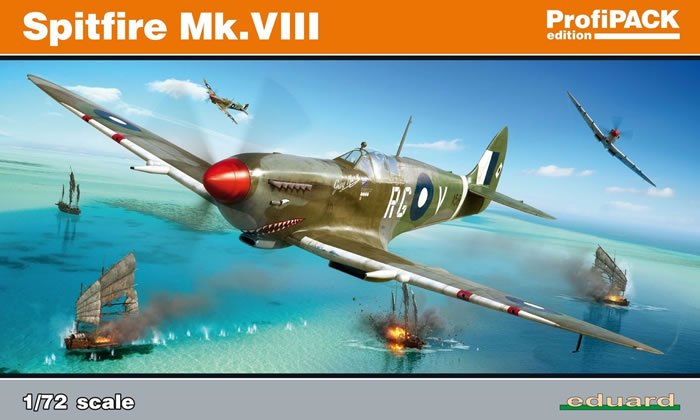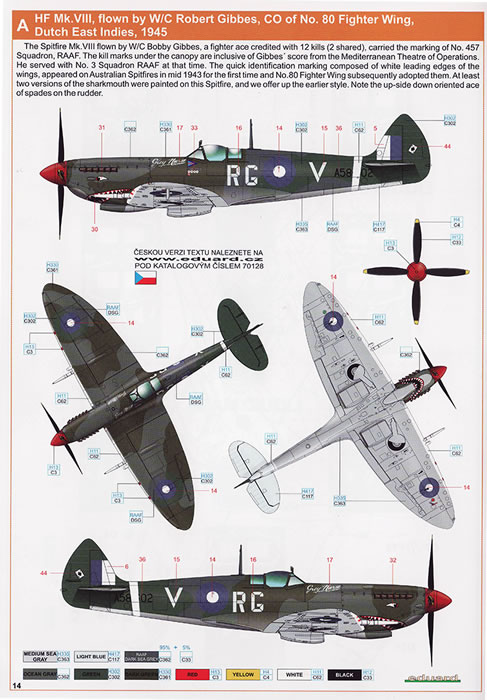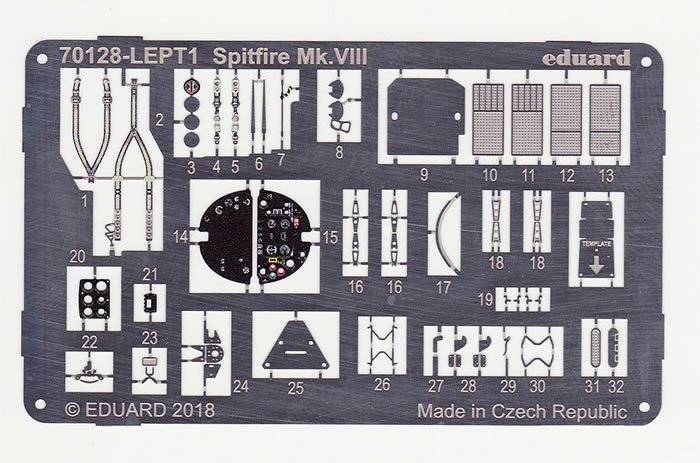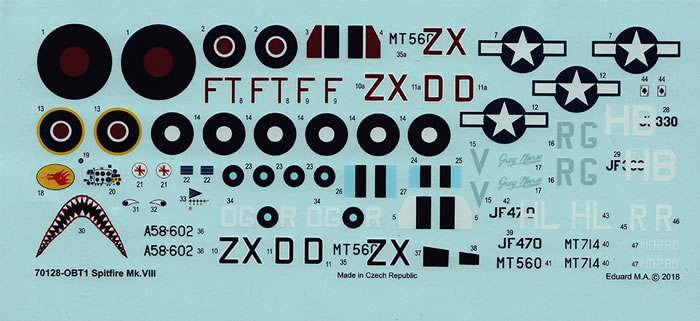Spitfire Mk.VIII
ProfiPACK

Eduard, 1/72 scale
Reviewed by David Couche

Eduard's 1/48 scale Bf 109 E-3 is available on sale from Squadron.com for only $21.99!
During 1941 work began on adapting the Spitfire to use the new Merlin 61 engine. This had a two-stage supercharger, which improved its performance at high altitude by around 50%. The new engine was fitted to Spitfire N3297 (the only Mk III Spitfire), and the modified aircraft first flew on 27 September 1941. The timing was perfect. September 1941 also saw the operational debut of the Fw 190. The new German fighter outclassed the Spitfire V, then the RAF’s best front line fighter. Tests early in 1942 proved that the Merlin 61 powered Spitfire was the answer – it reached a maximum speed of 414 mph at 27,200 feet and could still reach 354 mph at 40,000 feet.
Work began on redesigning the Spitfire airframe to take the new heavier more powerful engine. This work would produce the pressurised Mk VII and the unpressurised Mk VIII Spitfires. These aircraft were expected to be the answer to the Fw 190. In the event the interim Mk IX performed that function. This version used a Mk V fuselage with as few changes as possible, and entered front line service in July 1942, nearly a year before the Mk VIII.
The Mk VIII (and VII) featured a strengthened fuselage with a retractable tail wheel. Each wing carried a 14-gallon self-sealing fuel tank, and the main fuselage fuel tank was increased in size to 96 gallons. These changes gave the Mk VIII the same range as the Mk V, although as this distance was achieved at a higher speed, the Mk VIII could stay in the air for less time than the Mk V. Most Mk VIIIs used a new broad-chord, or pointed-tip rudder. It also featured a new tropical filter – the Vokes Aero-Vee – that was so well designed it was installed on all Mk VIIIs and adapted for the Mk IX. The Mk VIII used the “c” wing armament (four cannon or two cannon and two machine guns) and could carry up to 1,000lbs of bombs.

1,657 Mk VIIIs were produced in all, so although it never replaced the Mk IX in Britain and Northern Europe it was still a major version of the Spitfire. It was produced in three versions. The F.VIII using the 1,560 hp Merlin 61 was the standard fighter model. The HF.VIII used a 1,655hp Merlin 70 and was a high altitude fighter and the LF.VIII used the 1,705 hp Merlin 66 and was officially a low altitude fighter, although its best altitude was not that much lower than for the F.
The success of the Mk IX reduced the importance of the Mk VIII. Although the first production model was completed in November 1942, it took until June 1943 for the first squadron to be equipped with the model. One reason for the delay was that it had been decided to use the Mk VIII in the Mediterranean and Far East, and so the first squadron to use it was No. 145, based on Malta. By the summer of 1943 the crisis in the Mediterranean was in the past, and the Mk VIII saw most of its service during the invasion of Italy, often in a ground attack role.
The Mk VIII arrived in the Far East towards the end of 1943. This was just in time, for at the start of 1944 the Japanese launched their Arakan offensive. The Mk V Spitfire had been on a par with the best Japanese fighter in Burma, the Ki 44 “Tojo”, but the Mk VIII was much faster. The Japanese Army Air Force was soon driven from the skies over the Arakan, allowing the Allies to keep their isolated troops supplied from the air. The same pattern was repeated in March 1944 when the Allied air forces in India were able to keep 55,000 troops supplies at Kohima and Imphal.
Finally, the Mk VIII was used by the Royal Australian Air Force, at first for the defence of Darwin, but as the Japanese were pushed back it was more often used in the ground attack role, keeping the isolated Japanese garrisons pinned down.
* Please note article used above was from: Rickard, J (12 March 2007), Supermarine Spitfire Mk VIII
Regular HyperScale visitors might remember my review from about 6 weeks ago on the Brassin Spitfire Mk VIII Cockpit set, in which I mentioned my need to get a kit to put that wonderful set into.
Well, lo and behold, what should appear in the last box of goodies to review from Brett Green, but this kit. Thanks Brett and now there is no reason not to get this project going.
But firstly, what is in the kit you want to know.
The sturdy Eduard box firstly, is not a great deal smaller than the 1/48 boxing of the Mk VIII. The box is packed full of all the goodies you will need to make a really nicely detailed model of this Spitfire. The contents include, 5 grey injected moulded sprues with some 179 parts on them. Upon careful examination of the instructions I find that 61 of these parts are not to be used in this version, so the spares box will have plenty added to it. There is one clear sprue containing 15 very clear parts with 4 not used, a sheet of photoetch containing 32 parts, a sheets of masks and the usual comprehensive instruction booklet. All sprues are cleanly moulded with no flash evident and sprue gates to the parts appear to have been created to minimise their effect on the parts.
Sprue A
This sprue has 72 parts on it, with nearly half of these, 31, not used for this model. I believe many of these are relevant for the Mk IX version. It has a nicely moulded 4 blade prop, lovely detailed cockpit walls, tyres, a choice of wheel hubs and wheel-well parts.
Sprue B
Sprue B contains the undercarriage doors, legs, exhausts and more of the cockpit including a choice of instrument panels, raised detail or just a flat on to be used with the coloured etched instrument panel. This sprue also offers a choice of the cockpit door in open or closed modes, which is very useful. There are 58 parts on this sprue of which 14 ae not used.
Sprue C
This sprue is the clear sprue giving you a choice of the canopy open (3 parts) or closed with a 2 part design, the front windscreen and the remaining sections as one. This sprue has a bubble top canopy on it, obviously for the Mk XVI version.

There are plenty of lights to give a realistic finish to your model rather than the old painted method.
Sprues D and E
These 2 small sprues give you tail planes, a choice of wing tips standard, clipped and long as well as the metal ailerons. Again, nearly half the parts are not required, spares box here they come.
Sprue F
Finally we get to the sprue having the fuselage halves, wings, rudders (a choice between the pointed one and the rounder rudder. The fuselage and wings exhibit refined detail, both recessed and raised as is necessary. Rivets are fine and restrained and easily could disappear under a heavier coat of paint.

One poor thing noted and, to me (and many other fellow modellers I know of) totally un-necessary, is the way Eduard insists on doing the top engine cowl as a 2 piece construction. I do know from constructing the 1/48th versions that an aftermarket replacement one piece cowl is a most desirable addition to any of the Spitfire kits and this one is no different.
Photo-Etch
A very nice photoetch sheet of 32 parts is included in the Profipack which includes pre-coloured seat belts and instrument panel. There are many parts, such as the radiator and carburettor facings, as well small additions to the cockpit. One puzzling thing, is that, there is a template etch piece on the sheet.

I have carefully gone over the instructions quite a few times now and I can’t find any reference to it at all. Maybe for the Mk IX? Very puzzling!
Masking Sheet
A sheet of typical Eduard tape style masks completes the kit. These allow for masking of both open and closed canopies as well as masking for the wingtip, underwing and fuselage light. This is a very useful inclusion.
Instructions
The instructions for the kit are the usual Eduard, high quality detailed instructions, with copious colour call outs throughout, using the Gunze Aqueous and Mr Color range.
Markings
The decals appear to be in perfect register giving the options for 6 different aircraft.

Included is a comprehensive stencil and data sheet, with a separate page at the end of the instructions for their placement.

I have included a scan of the 6 aircraft profiles but briefly, they are;
-
HF Mk VIII flown by W/C Robert Gibbes, CO No. 80 Fighter Wing, RAAF, Dutch East Indies, 1945
-
LF Mk VIII, MT560, flown by Lt Antony Broke Woodley, No.145 Sq, RAF, Bellaria-Igea Marina, Italy, March 1945
-
F Mk VIII, JF470, 308th Fighter Sq, 31st Fighter Group, USAF, Fano Air Base, Italy, 1944-45
-
F Mk VIII, JF330, flown by AVM Harry Broadhurst, RAF 1943
-
LF Mk VIII, MD280, flown by F/Lt Paul Ostrander, No.155 Sq, RAF, Burma, 1945
-
LF Mk VIII, MT714, flown by F/Lt A.W.Guest, No.43 Sq RAF, Ramatuelle Airfield, France, August 1944
All in all, a very nice, well detailed kit. The Eduard Spitfire Mk VIII kit ticks all the right boxes, a great choice of airframes covering all possible wing tip and tail variations from four different theatres of operations.
I just need to complete a couple of models already on the bench and then get into this little beauty, along with the previously reviewed Brassin Cockpit set.
Thanks to Eduard for the sample

Review Text & Images Copyright © 2018 by David Couche
Page Created 16 July, 2018
Last updated
16 July, 2018
Back to HyperScale Main Page
Back to Reviews Page |
